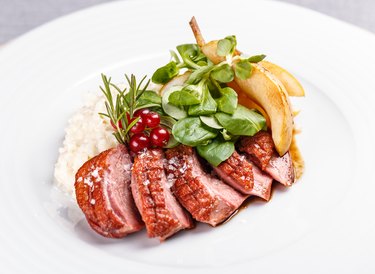
Goose breast can be cooked like any other type of fowl. Braising, broiling, grilling and stewing are all common methods to use in goose breast recipes. The optimal cooking method for your goose breast will depend on whether you want it to be medium-rare, medium or well done.
Read more: 15 of the Best Lean Animal Proteins
Video of the Day
Video of the Day
Tip
Goose breast can be cooked in a variety of ways. However, regardless of the method you've chosen, goose breast is considered fully cooked when it's reached an internal temperature of 160 degrees Fahrenheit.
Goose Breast Cooking Temperatures
Goose breast can be cooked in a variety of ways. However, before you start contemplating different goose breast recipes, you'll need to figure out how you'd like your goose to be cooked.
Unlike other types of poultry, goose isn't always cooked all the way through. The USDA states that there's still a risk of salmonella poisoning when consuming undercooked goose and other birds, though. Consequently, even though the restaurant standard may be to cook your goose medium-rare, recipes may also recommend you cook it until it's well done.
According to the USDA, you should cook goose breast at temperatures between 325 degrees Fahrenheit (163 degrees Celcius) and 425 degrees Fahrenheit (218 degrees Celcius). Most goose breasts need a cooking time of 30 to 45 minutes. The exact cooking time depends on the size of your goose breast.
It's usually best to use a cooking thermometer to check the internal goose breast temperature. Medium-rare to medium goose breasts have an internal temperature between 135 and 145 degrees Fahrenheit (57 to 63 degrees Celcius).
If you prefer to consume a well-done goose breast, the internal temperature has to be a bit higher. Once your goose breast reaches an internal temperature of 160 degrees Fahrenheit (71 degrees Celsius), the meat will be cooked all the way through and there won't be any pink remaining.
Goose Breast Recipes
Although you might find goose breast pastrami or cured goose meats sold at your local butcher shop, most goose breast recipes involve a whole goose breast being served as the star of the meal. These recipes typically ask you to brown the goose breast skin-side down to crisp the skin. You then cook your breast in the oven until it's reached the internal temperature of your choosing.
If you prefer consuming well-done goose meat, be aware that this type of recipe is likely to dry out your meat. It may be better to choose goose breast recipes like stewing and braising instead. These techniques result in a fully cooked goose breast that's juicy and tender. Cooking wild goose breast in a slow cooker is another particularly good way to make sure that your goose has been thoroughly cooked, but remains moist.
Stewing, braising and other similar cooking techniques are also very healthy. The Mayo Clinic recommends choosing cooking methods like these because they incorporate less additional fat into your meals.
Goose Meat's Nutritional Benefits
A whole goose breast is a very large piece of meat. According to the USDA, one breast weighs 635 grams (22.5 ounces), which is the equivalent of around seven and a half servings.
If you were to consume a standard 3-ounce (85 gram) serving of skinless goose breast, you'd be consuming 113 calories, 20.7 grams of protein, 3.4 grams of fat and large amounts of essential nutrients like B-complex vitamins and manganese.
Goose is known for being a fairly fatty meat. However, goose breast, like turkey and chicken breast, is one of the least fatty cuts.
If you enjoy eating goose regularly, try to stick to consuming skinless goose breasts. That way, you're consuming minimal amounts of saturated fat. The American Heart Association recommends minimizing saturated fat intake in order to maintain good cardiovascular health.